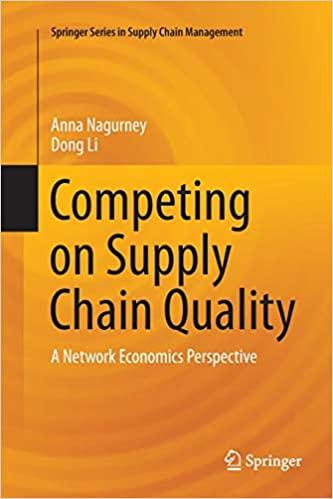Question
Hart Manufacturing makes three products. Each product requires manufacturing operations in three departments: A, B, and C. The labor-hour requirements, by department, are as follows.
Hart Manufacturing makes three products. Each product requires manufacturing operations in three departments: A, B, and C. The labor-hour requirements, by department, are as follows. Department Product 1 Product 2 Product 3 A 1.50 3.00 2.00 B 2.00 1.00 2.50 C 0.25 0.25 0.25 During the next production period, the labor-hours available are 450 in department A, 350 in department B, and 50 in department C. The profit contributions per unit are $25 for product 1, $27 for product 2, and $29 for product 3. (a) Formulate a linear programming model for maximizing total profit contribution. (Let Pi = units of product i produced, for i = 1, 2, 3.) Max Correct: Your answer is correct. s.t. Department A Correct: Your answer is correct. Department B Correct: Your answer is correct. Department C Correct: Your answer is correct. P1, P2, P3 0 (b) Solve the linear program formulated in part (a). How much of each product should be produced, and what is the projected total profit contribution (in dollars)? (P1, P2, P3) =
Correct: Your answer is correct.
with profit $ Correct: Your answer is correct. . (c) After evaluating the solution obtained in part (b), one of the production supervisors noted that production setup costs had not been taken into account. She noted that setup costs are $410 for product 1, $540 for product 2, and $650 for product 3. If the solution developed in part (b) is to be used, what is the total profit contribution (in dollars) after taking into account the setup costs? $ Correct: Your answer is correct. (d) Management realized that the optimal product mix, taking setup costs into account, might be different from the one recommended in part (b). Formulate a mixed-integer linear program that takes setup costs into account. Management also stated that we should not consider making more than 140 units of product 1, 175 units of product 2, or 180 units of product 3. (Let Pi = units of product i produced and yi be the 0-1 variable that is one if any quantity of product i is produced and zero otherwise, for i = 1, 2, 3.) What is the objective function of the mixed-integer linear program? Max Correct: Your answer is correct. In addition to the constraints from part (a), what other constraints should be added to the mixed-integer linear program? s.t. units of Product 1 produced Correct: Your answer is correct. units of Product 2 produced Correct: Your answer is correct. units of Product 3 produced Correct: Your answer is correct. P1, P2, P3 0; y1, y2, y3 = 0, 1 (e) Solve the mixed-integer linear program formulated in part (d). How much of each product should be produced, and what is the projected total profit (in dollars) contribution? (P1, P2, P3, y1, y2, y3) =
Incorrect: Your answer is incorrect.
with profit $
Step by Step Solution
There are 3 Steps involved in it
Step: 1

Get Instant Access to Expert-Tailored Solutions
See step-by-step solutions with expert insights and AI powered tools for academic success
Step: 2

Step: 3

Ace Your Homework with AI
Get the answers you need in no time with our AI-driven, step-by-step assistance
Get Started


